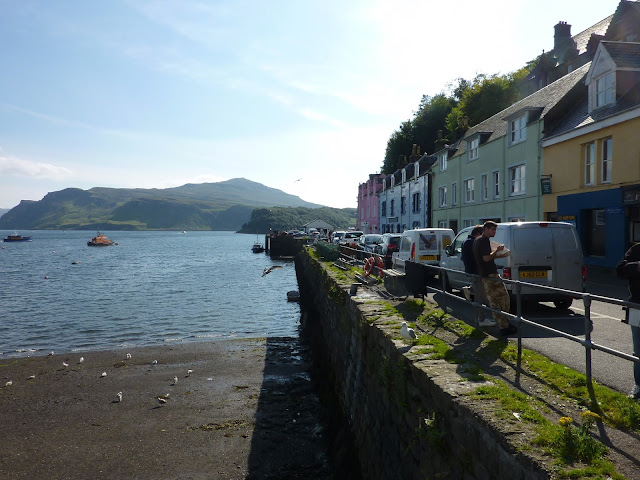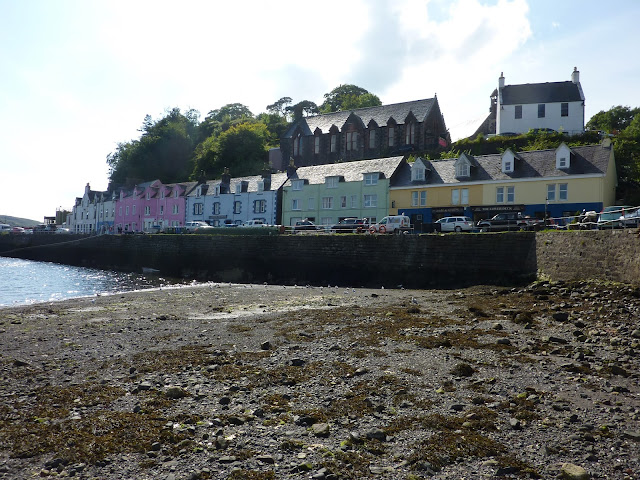Along with Edinburgh and Loch Ness, Skye is one of the top
tourist destinations in Scotland and after visiting the island one can
understand why. In the Lonely Planet guidebook of Scotland it is described as ‘a 50 mile long patchwork of velvet moors,
jagged mountains, sparkling Lochs and towering sea cliffs’. Its stunning scenery
is certainly one of its main attractions. Skye takes its name from the Old
Norse word meaning ‘Cloud Island’. Clouds and bad weather is in all honesty
what we expected, but how wrong can you be! The weather was beautiful only one
rather frightening gale at night and a morning of light rain. The rest of our six-night
stay on the edge of Loch Greshornish was bathed in sunshine and temperatures that
were rarely witnessed during the summer. Concentrating only on the northern
half of the island for this visit left plenty to discover and explore.
Our first venture out was close to our accommodation. A
short walk to Upper Edinbane and through its picturesque village with views
over the loch and up to Airgh Neil electro site across scrubland to see the wind
turbines up close. Beautiful creatures
that hum quietly to them selves, much bigger up close than one would expect!
Although Dunvegan itself is hardly worth a visit with its limited amount of attractions but carry on passed the village and you come to Dunvegan Castle and Gardens, Skye’s most famous historical building and the oldest continuously inhabited castle in Scotland. Ancestral home of the Chiefs of clan MacLeod for 800 years it has played host to Samuel Johnson, Sir Walter Scott and most famously Flora MacDonald, more of whom later. Lots of really interesting artefacts including the famous Fairy Flag are on display. And then there are the unbelievably splendid gardens.
These magnificent
gardens will prove of considerable interest to many, following paths
through woodland glades, past shimmering pools and burns fed by a cascading
waterfall. Stroll through the formal round garden, stand and admire the many
Rhododendrons, numerous in their variety. The Castle Gardens were originally
laid out in the 18th century and considerable replanting and landscaping
provides a legacy, which current as well as future generations can enjoy and
admire. The Castle gardens lie inland and are backed by a considerable number
of hectares (1 hectare = 2.471 acres) of mature woodland.
As the Isle of Skye is
essentially made up of barren moorland and hill these woods and gardens are
like reaching a hidden oasis. Many visitors are surprised at the sheer variety
of species of plant and tree that not only survive but also thrive at Dunvegan.
The secret is a brilliant, inspired and dedicated team of horticulturalists and
garden staff as well as a little bit of help from nature as Dunvegan
Castle is in the "Gulf Stream". Plants men and women from all over
the country, indeed the world visits the castle and is inspired by what they
find.[1]
Beyond the castle entrance there is long narrow single-track
road at the end of which you will find a car park. From this point there is
just over a mile to walk before you reach a shoreline known as the Coral
Beaches. These beaches are formed from the bleached skeletons of red coralline
seaweed known as maerl (pronounced marl). Maerl grows at a rate of around 1mm
per year and some maerl beds are reputed to be around 8000 years old. This area
is a most see, perfect scenery and surroundings and while you’re there climb
up the small incline that borders the beach for some wonderful views across to
the islands of Lampay and Isay and views of Waternish round to Dunvegan Head.
Pick up a number 56 bus on the main road above Loch
Greshornish and it will take you into Skye’s largest town Portree. Film fans
may recognise it as the name of a fictional Quidditch team, the Pride of
Portree, which is featured in the Harry Potter movies. The town has its fair share of historical buildings
dating back to the 1800’s, a grand harbour lined by brightly painted houses and
a pier designed by Thomas Telford and not forgetting a fish and chip
restaurant. It is also the location for
the only secondary school on the Island, Portree High School,
considering the size of the island some of its pupils must have quite a journey.
Driving to the Trotternish Peninsula we sampled some of
Skye’s beautiful and at times bizarrely enchanting landscapes.
The Old Man of Storr is a 50 metre high pinnacle of basalt
and is prominent above the road way from Portree.
The impressive range of land slipped cliffs and pinnacles
known as the Quiraing dominates all that surrounding it.
Crofting life in the 18th and 19th
century is on display in the authentic setting of croft houses, barns and farm
implements in the Skye Museum of Island Life.
A short walk from the crofting village is the grave of Flora
MacDonald[2]. During
the Jacobite Risings, in June 1746, at the age of 24, she was living on
the island of Benbecula in the Outer Hebrides when Bonnie Prince
Charlie took refuge there after the Battle of Culloden. The prince's
companion, a Captain Conn O'Neill of The Feeva, County Antrim, sought her
assistance to help the prince escape capture which she successfully did
dressing him in ladies clothes.
From the moment you cross the magnificent Skye Bridge it doesn’t
matter where you go on Skye there are always jaw-dropping views, and places of
great interest. Its enchanting nature ensures that once visited that you will
always be drawn back.






































No comments:
Post a Comment